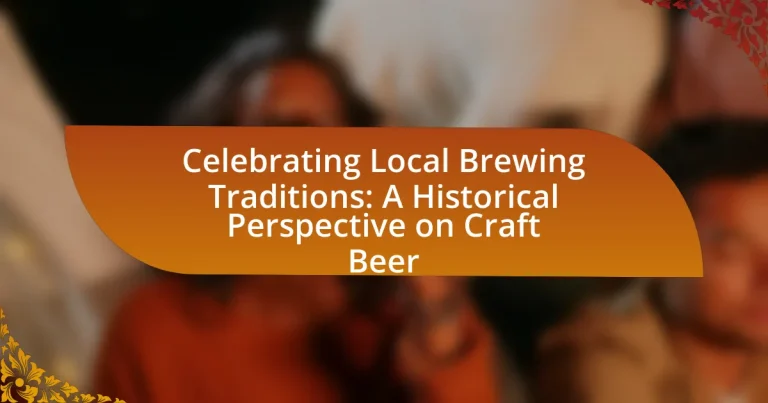Local brewing traditions encompass the unique methods, ingredients, and cultural practices associated with beer production in specific regions, reflecting local history and resources. The article explores the evolution of these traditions from communal home brewing to the rise of craft breweries, emphasizing their importance in fostering community identity and economic growth. It highlights significant historical events, cultural influences, and the impact of the craft beer movement, which has gained popularity due to consumer demand for quality and local products. Additionally, the article discusses how local brewing contributes to community engagement and the economy, while providing insights into best practices for supporting local breweries and celebrating their heritage through events and festivals.

What are Local Brewing Traditions?
Local brewing traditions refer to the unique methods, ingredients, and cultural practices associated with beer production in specific regions. These traditions often reflect local history, climate, and available resources, resulting in distinct styles and flavors. For example, Belgium is renowned for its Trappist beers, brewed by monks using centuries-old techniques, while Germany is famous for its Reinheitsgebot, or beer purity law, which dictates the ingredients that can be used. Such traditions not only preserve local heritage but also contribute to the diversity of craft beer globally, as evidenced by the rise of microbreweries that celebrate regional ingredients and brewing methods.
How have local brewing traditions evolved over time?
Local brewing traditions have evolved significantly over time, transitioning from small-scale, home-based production to large commercial operations and craft breweries. Historically, brewing was a communal activity, often performed by women in households, utilizing locally available ingredients. With the advent of industrialization in the 19th century, brewing became mechanized, leading to mass production and the rise of major beer brands.
In recent decades, the craft beer movement has revitalized local brewing traditions, emphasizing quality, unique flavors, and regional ingredients. According to the Brewers Association, the number of craft breweries in the United States grew from 8 in 1980 to over 8,000 by 2020, showcasing a resurgence of interest in local and artisanal brewing practices. This evolution reflects a broader cultural shift towards valuing local products and sustainable practices in the beverage industry.
What historical events influenced the development of local brewing?
The development of local brewing has been significantly influenced by events such as the establishment of the Reinheitsgebot in 1516, which regulated beer purity in Germany, and the Industrial Revolution, which introduced mechanization to brewing processes. The Reinheitsgebot ensured that only water, barley, and hops were used in beer production, promoting quality and standardization in local brewing practices. The Industrial Revolution, occurring in the late 18th to early 19th centuries, led to advancements in brewing technology, such as steam power and refrigeration, which allowed for larger-scale production and distribution of beer, thus shaping local brewing traditions. Additionally, Prohibition in the United States from 1920 to 1933 forced many local breweries to close, but it also led to a resurgence of craft brewing in the late 20th century as homebrewing became popular and small breweries began to emerge, revitalizing local brewing culture.
How do cultural factors shape local brewing practices?
Cultural factors significantly shape local brewing practices by influencing the ingredients used, brewing techniques, and the social contexts in which beer is consumed. For instance, in regions with a strong agricultural tradition, local grains and crops often become the primary ingredients, leading to unique flavor profiles that reflect the local terroir. Additionally, cultural rituals and celebrations can dictate specific brewing styles; for example, certain festivals may inspire the production of seasonal beers that align with local customs. Historical practices, such as those seen in Germany with its Reinheitsgebot (beer purity law), further illustrate how cultural norms can establish standards and expectations in brewing. These cultural influences create a diverse landscape of brewing practices that are deeply rooted in the identity and heritage of local communities.
Why are local brewing traditions important to communities?
Local brewing traditions are important to communities because they foster cultural identity and social cohesion. These traditions often reflect the unique history, values, and tastes of a community, creating a sense of belonging among residents. For instance, local breweries frequently source ingredients from nearby farms, which supports the local economy and promotes sustainable practices. Additionally, events such as beer festivals and brewery tours encourage community engagement and provide opportunities for social interaction, strengthening community ties. Historical data shows that regions with strong brewing traditions often experience increased tourism, further benefiting local businesses and enhancing community pride.
What role does local brewing play in community identity?
Local brewing significantly contributes to community identity by fostering a sense of belonging and cultural heritage. It serves as a platform for local artisans to express regional flavors and traditions, which strengthens community ties. For instance, craft breweries often incorporate local ingredients and brewing techniques that reflect the area’s history and agricultural practices, creating unique products that resonate with residents. This connection is evidenced by the rise of community events centered around local breweries, such as beer festivals and tasting events, which promote social interaction and local pride. Additionally, studies have shown that communities with active local brewing scenes experience increased economic benefits and tourism, further solidifying their identity as vibrant, culturally rich areas.
How does local brewing contribute to the local economy?
Local brewing significantly contributes to the local economy by creating jobs, stimulating tourism, and supporting local agriculture. Breweries often employ a range of workers, from brewers to bartenders, which boosts local employment rates. According to the Brewers Association, the craft brewing industry supported over 1.1 million jobs in the United States in 2020. Additionally, local breweries attract tourists, who spend money on food, lodging, and other local attractions, further enhancing economic activity. Furthermore, many breweries source ingredients from local farmers, fostering agricultural growth and sustainability in the region. This interconnectedness between brewing and local resources strengthens the overall economic framework of the community.

What is Craft Beer?
Craft beer is a type of beer that is produced by small, independent breweries, emphasizing quality, flavor, and traditional brewing methods. These breweries typically produce limited quantities of beer, often focusing on unique styles and local ingredients. According to the Brewers Association, a craft brewery is defined as a brewery that produces less than six million barrels of beer annually, is independently owned, and has a strong commitment to traditional brewing practices. This definition highlights the distinctiveness of craft beer in contrast to mass-produced beers, which prioritize volume over quality.
How does craft beer differ from mass-produced beer?
Craft beer differs from mass-produced beer primarily in its production scale and approach to brewing. Craft beer is typically produced by small, independent breweries that emphasize quality, flavor, and traditional brewing methods, often using unique ingredients and innovative techniques. In contrast, mass-produced beer is manufactured by large corporations focused on high-volume production, consistency, and cost-efficiency, often resulting in a more homogenized flavor profile. According to the Brewers Association, craft breweries produced 23.1 million barrels of beer in 2020, representing 23.1% of the U.S. beer market, highlighting the significant cultural and economic impact of craft beer compared to the dominant mass-produced brands.
What are the defining characteristics of craft beer?
Craft beer is defined by its emphasis on quality, flavor, and traditional brewing methods. It typically involves small-scale production, often by independent breweries, which allows for creativity and innovation in flavor profiles. According to the Brewers Association, craft beer must be produced by a brewery that is small (producing less than six million barrels annually), independent (less than 25% owned by a non-craft entity), and traditional (using traditional ingredients and brewing methods). These characteristics contribute to the unique and diverse offerings found in the craft beer market, distinguishing it from mass-produced beers.
How do brewing methods vary between craft and commercial breweries?
Brewing methods differ significantly between craft and commercial breweries, primarily in scale, ingredients, and techniques. Craft breweries often utilize traditional methods, emphasizing quality and unique flavors, with a focus on small-batch production that allows for experimentation with various ingredients. In contrast, commercial breweries typically employ large-scale, automated processes designed for efficiency and consistency, often using adjuncts and preservatives to maximize production and shelf life. For example, the Brewers Association defines craft breweries as those producing less than six million barrels annually, highlighting their commitment to traditional brewing practices and local ingredients, which contrasts with the mass production strategies of larger commercial entities.
Why has the craft beer movement gained popularity?
The craft beer movement has gained popularity due to a growing consumer preference for unique flavors and local products. This shift is driven by an increasing desire for authenticity and quality in beverages, as craft breweries often emphasize traditional brewing methods and local ingredients. According to the Brewers Association, the number of craft breweries in the United States grew from 1,500 in 2000 to over 8,000 by 2020, reflecting a significant rise in consumer interest. Additionally, craft beer offers a diverse range of styles and flavors, appealing to adventurous drinkers seeking new experiences.
What factors have contributed to the rise of craft breweries?
The rise of craft breweries has been primarily driven by consumer demand for unique and locally produced beers. This shift in consumer preferences has led to an increased interest in artisanal products, with craft breweries offering diverse flavors and styles that differentiate them from mass-produced beers. Additionally, the deregulation of brewing laws in many regions has facilitated the establishment of small breweries, allowing entrepreneurs to enter the market more easily. According to the Brewers Association, the number of craft breweries in the United States grew from 1,500 in 2000 to over 8,000 by 2019, highlighting the significant growth in this sector. Furthermore, the craft beer movement has been supported by a strong community focus, with many breweries engaging in local events and collaborations, further enhancing their appeal to consumers seeking authentic experiences.
How do consumer preferences influence the craft beer market?
Consumer preferences significantly influence the craft beer market by driving demand for unique flavors, local sourcing, and sustainable practices. As consumers increasingly seek diverse and innovative beer options, craft breweries respond by experimenting with ingredients and brewing techniques, leading to a wider variety of products. According to the Brewers Association, craft beer sales grew by 21% in 2020, reflecting a shift towards local and artisanal products that cater to consumer desires for authenticity and quality. This trend indicates that consumer preferences not only shape the types of beers produced but also encourage breweries to adopt practices that resonate with their target audience, such as eco-friendly brewing methods and community engagement.

How can we celebrate local brewing traditions today?
To celebrate local brewing traditions today, communities can organize craft beer festivals that showcase regional breweries and their unique offerings. These festivals not only highlight local flavors but also foster connections between brewers and consumers, enhancing appreciation for traditional brewing methods. For instance, events like the Great American Beer Festival feature local breweries, allowing them to present their craft and educate attendees about their brewing heritage. Additionally, supporting local breweries through purchasing their products and visiting taprooms helps sustain these traditions, as evidenced by the rise in craft beer sales, which accounted for 23.1% of the overall beer market in 2020, according to the Brewers Association.
What events and festivals highlight local brewing traditions?
Events and festivals that highlight local brewing traditions include Oktoberfest, the Great American Beer Festival, and local craft beer weeks. Oktoberfest, held annually in Munich, Germany, celebrates traditional German beer culture and attracts millions of visitors, showcasing local breweries and their unique offerings. The Great American Beer Festival, hosted in Denver, Colorado, features thousands of craft beers from across the United States, emphasizing regional brewing styles and innovations. Additionally, many cities host craft beer weeks, which promote local breweries through tastings, tours, and educational events, fostering community engagement and appreciation for local brewing heritage.
How do these events promote community engagement?
Events celebrating local brewing traditions promote community engagement by fostering social interaction and collaboration among residents. These gatherings create opportunities for individuals to connect over shared interests in craft beer, enhancing local identity and pride. For instance, community festivals often feature local breweries, which not only showcase regional products but also encourage conversations and relationships among attendees. Research indicates that such events can increase community cohesion, as they provide a platform for local artisans and businesses to interact with the public, thereby strengthening economic ties and social networks within the community.
What are some notable local brewing festivals around the world?
Notable local brewing festivals around the world include the Great American Beer Festival in the United States, which features over 4,000 beers from more than 800 breweries, and Oktoberfest in Munich, Germany, renowned for its massive beer tents and traditional Bavarian culture. Other significant festivals are the Belgian Beer Weekend in Brussels, showcasing Belgium’s rich brewing heritage, and the Melbourne International Beer Festival in Australia, which celebrates craft beer with tastings and events. Each of these festivals highlights local brewing traditions and attracts thousands of attendees, reinforcing the cultural significance of craft beer in their respective regions.
What are best practices for supporting local breweries?
To support local breweries effectively, consumers should prioritize purchasing their products directly from the brewery, as this maximizes the financial benefit for the business. Engaging in community events, such as brewery tours and tastings, fosters a deeper connection between consumers and local brewers, enhancing brand loyalty. Additionally, promoting local breweries on social media platforms increases their visibility and encourages others to support them. According to the Brewers Association, local breweries contribute significantly to the economy, with craft breweries generating over $82 billion in economic impact in the United States in 2020, highlighting the importance of community support for their sustainability and growth.
How can consumers make informed choices when selecting craft beer?
Consumers can make informed choices when selecting craft beer by researching breweries, understanding beer styles, and reading labels. Researching breweries allows consumers to learn about the brewing process, ingredients, and local traditions, which can enhance appreciation for the craft. Understanding beer styles helps consumers identify their preferences, as craft beer encompasses a wide range of flavors and aromas. Reading labels provides essential information about alcohol content, ingredients, and brewing methods, enabling consumers to make choices aligned with their tastes and dietary restrictions. This approach is supported by the growing trend of craft beer education, which emphasizes the importance of informed decision-making in enhancing the overall beer experience.
What role do local governments play in supporting brewing traditions?
Local governments play a crucial role in supporting brewing traditions by implementing policies that promote local breweries and craft beer culture. They often provide financial incentives, such as grants or tax breaks, to encourage the establishment and growth of breweries, which can stimulate local economies. Additionally, local governments may facilitate events like beer festivals or brewery tours, enhancing community engagement and tourism. For example, cities like Portland, Oregon, have seen significant economic benefits from their support of craft breweries, contributing to a vibrant local culture and job creation.


